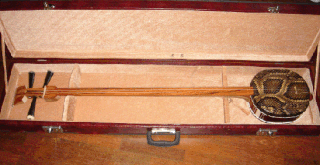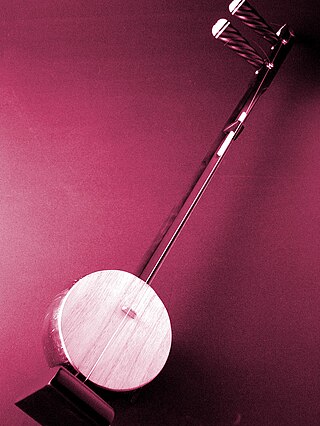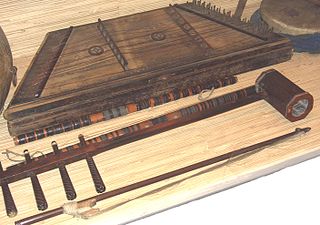
The erhu is a Chinese two-stringed bowed musical instrument, more specifically a spike fiddle, which may also be called a southern fiddle, and is sometimes known in the Western world as the Chinese violin or a Chinese two-stringed fiddle.
The sanshin is an Okinawan and Amami Islands musical instrument and precursor of the mainland Japanese shamisen. Often likened to a banjo, it consists of a snakeskin-covered body, neck and three strings.
Bowed string instruments are a subcategory of string instruments that are played by a bow rubbing the strings. The bow rubbing the string causes vibration which the instrument emits as sound.
The musical traditions of Central Asia mirror the immense diversity found in the cultures and populations residing in the region. Principal instrument types are two- or three-stringed lutes, the necks either fretted or fretless; fiddles made of horsehair; flutes, mostly sige at both ends and either end-blown or side-blown; and jew harps, mostly metal. Percussion instruments include frame drums, Tam origin of the bowed string Use of the bowed string is thought to originate with nomads who mainly used the snake-skin, covered horsetail-bowed lute. In Mongolia instruments like the morin khuur or horse-head fiddle survive today.

Wong khrueang sai is a musical ensemble in Thai classical music which consists primarily of string instruments. A typical khrueang sai ensemble features two two-string fiddles, one high and one low, a three-string zither called jakhe, a vertical duct flute called khlui, hand drums, and various cymbals. Depending on the size of the ensemble, instruments may be doubled or left out. A three-string spike fiddle called saw sam sai may be added as well. The khim has become popular and is also used in this ensemble. In the 20th century, Western instruments such as the violin or organ have also occasionally been integrated into khrueang sai ensembles.

The rebab is the name of several related string instruments that independently spread via Islamic trading routes over much of North Africa, Middle East, Central Asia, Southeast Asia, and parts of Europe. The instrument is typically bowed, but is sometimes plucked. It is one of the earliest known bowed instruments, named no later than the 8th century, and is the parent of many bowed and stringed instruments.

The sanxian is a three-stringed traditional Chinese lute. It has a long fretless fingerboard, and the body is traditionally made from snake skin stretched over a rounded rectangular resonator. It is made in several sizes for different purposes and in the early 20th century a four-stringed version, the jiaxian sanxian (加弦三弦), was developed. The northern sanxian is generally larger, at about 122 cm (48 in) in length, while southern versions of the instrument are usually about 95 cm (37 in) in length.

Huqin is a family of bowed string instruments, more specifically, a spike fiddle popularly used in Chinese music. The instruments consist of a round, hexagonal, or octagonal sound box at the bottom with a neck attached that protrudes upwards. They also usually have two strings, and their soundboxes are typically covered with either snakeskin or thin wood. Huqin instruments usually have two tuning pegs, one peg for each string. The pegs are attached horizontally through holes drilled in the instrument's neck. Most huqin have the bow hair pass in between the strings. Exceptions to having two strings and pegs include variations of huqin with three, four, and sometimes even more than five. These include the zhuihu, a three stringed huqin, the sihu, a huqin of Mongolian origin, and the sanhu, a lesser-known three-stringed variation.

The jinghu is a Chinese bowed string instrument in the huqin family, used primarily in Beijing opera. It is the smallest and highest pitched instrument in the huqin family. The jinghu has a tone similar to a violin but raspier.

The banhu is a Chinese traditional bowed string instrument in the huqin family of instruments. It is used primarily in northern China. Ban means a piece of wood and hu is short for huqin.

The sihu is a Chinese bowed string instrument with four strings. It is a member of the huqin family of instruments.

A violin consists of a body or corpus, a neck, a finger board, a bridge, a soundpost, four strings, and various fittings. The fittings are the tuning pegs, tailpiece and tailgut, endpin, possibly one or more fine tuners on the tailpiece, and in the modern style of playing, usually a chinrest, either attached with the cup directly over the tailpiece or to the left of it. There are many variations of chinrests: center-mount types such as Flesch or Guarneri, clamped to the body on both sides of the tailpiece, and side-mount types clamped to the lower bout to the left of the tailpiece.

The tro is Cambodia's traditional spike fiddle, a bowed string instrument that is held and played vertically. Spike fiddles have a handle that passes through the resonator, often forming a spike, on the bottom side where it emerges. The family is similar or distantly related to the Chinese erhu or huqin. The instruments have a soundbox at the bottom of the stick, covered with leather or snake skin. Strings run from pegs at the top of the stick and secured at the bottom, running across the soundbox. The larger the soundbox, the lower the pitch range. Instruments in this family include the two-stringed tro ou, tro sau thom, tro sau toch and tro che, as well as the three-stringed tro Khmer spike fiddle. The two-stringed tros are tuned in a fifth, while the three-stringed tro Khmer is tuned in fourths. The tros, with the exception of the tro Khmer, are strung so that the bowstring is permanently placed between the two stings. When the musician plays, the placement of the bow causes the strings to be played at once, one from below and one from above. In contrast, western fiddles are played with the bow pushing on each string from the outside, as is also the case with the tro khmer.

The saw sam sai is a traditional bowed string instrument of Thailand. It is in the saw family of Thai fiddles, which also includes the saw u and saw duang, but unlike the other two, it has three strings and a bow that is separate from the instrument.

The đàn nhị, also called đàn cò, is a Vietnamese bowed string instrument with two strings. The word nhị means "two" in Sino-Vietnamese, and đàn means "instrument". Its sound box is generally covered on one end with snakeskin.
The tiqin is a name applied to several two-stringed Chinese bowed string musical instruments in the huqin family of instruments.
The yehu is a bowed string instrument in the huqin family of Chinese musical instruments. Ye means coconut and hu is short for huqin. It is used particularly in the southern coastal provinces of China and in Taiwan. The instrument's soundbox is made from a coconut shell, which is cut on the playing end and covered with a piece of coconut wood instead of the snakeskin commonly used on other huqin instruments such as the erhu or gaohu. As with most huqin the bow hair passes in between the two strings. Many players prefer to use silk strings rather than the more modern steel strings generally used for the erhu, giving the instrument a distinctly hollow, throaty timbre. The instrument comes in various sizes. In Chaozhou music it is a leading instrument, and is tuned quite high. In Cantonese music it can be quite large and is often tuned to a relatively low pitch, lower than the erhu. It is used as an accompaniment instrument in the local musics and operas of various areas, including Guangdong, Fujian, and Taiwan. It is an important instrument in the music of the Chaozhou and Hakka peoples. In Taiwan, a variety of yehu used in Taiwan opera is called kezaixian.
Traditional Thai musical instruments are the musical instruments used in the traditional and classical music of Thailand. They comprise a wide range of wind, string, and percussion instruments played by both the Thai majority as well as the nation's ethnic minorities.

The saw u is a Thai bowed string instrument. It has a lower pitch than the saw duang and is the lowest sounding of the saw family.
















